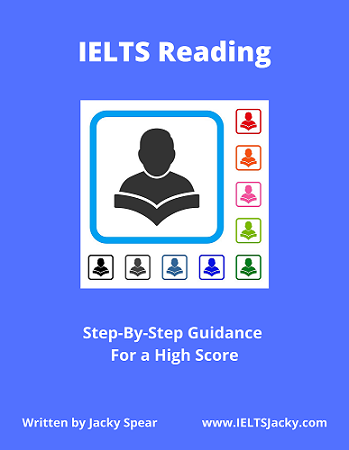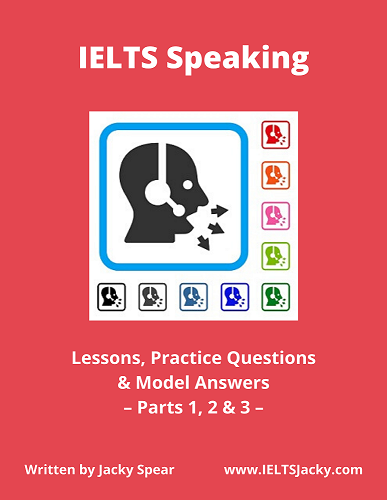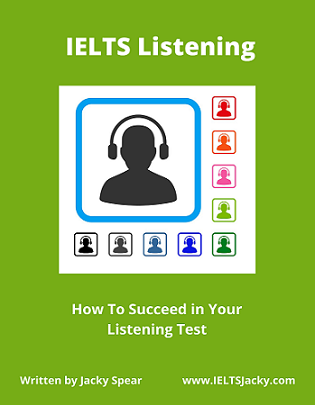IELTS Reading
Name Matching Questions
There is a good chance that you will get a name matching question in your IELTS Reading test. These can seem quite simple at first sight as it’s easy to find the location of the answers. However, you’re ability to interpret the text will be put to the test here.
I want to give you all the help I can and include in this page:
- An overview of skills needed
- The task
- Key tips
- A proven strategy
- Examples & model answers
Skills needed
Name matching questions test your ability to:
- Scan the text for names
- Recognise synonyms & paraphrasing
- Use context to guess meaning
They also require you to recognise at least one of the following:
- an expression of opinion
- a theory
- research findings
The task
For name
matching questions, you have to match a list of people’s names to a list of
statements using the information in the text to make the correct matches.
The names will normally be of:
- researchers
- experts
- scientists
The
statements will normally be:
- research findings
- theories
- years
- places
Key tips
- The statements will not appear in the same order in the text as they are listed in the instructions. Neither will the names appear in the same order that they are listed.
- The statements will usually paraphrase information in the text.
- Some of the names might be shortened in the text to an initial and surname, or just the first name or last name might be used. For example, ‘Gregor Borek’ may be shortened to ‘G. Borek’, ‘Gregor’ or ‘Borek’.
- It can be helpful to have different coloured pens to underline the different names in the text.
- Don’t spend too long on any one statement. If you get stuck, move on to the next one. Come back to it when you’ve eliminated other statements and there are thus fewer to choose from.
- In some test papers, there will be more statements than there are names and you will be told in the instructions that you can use a letter (i.e. a name) more than once. This is the case in the following instructions from a real test paper.
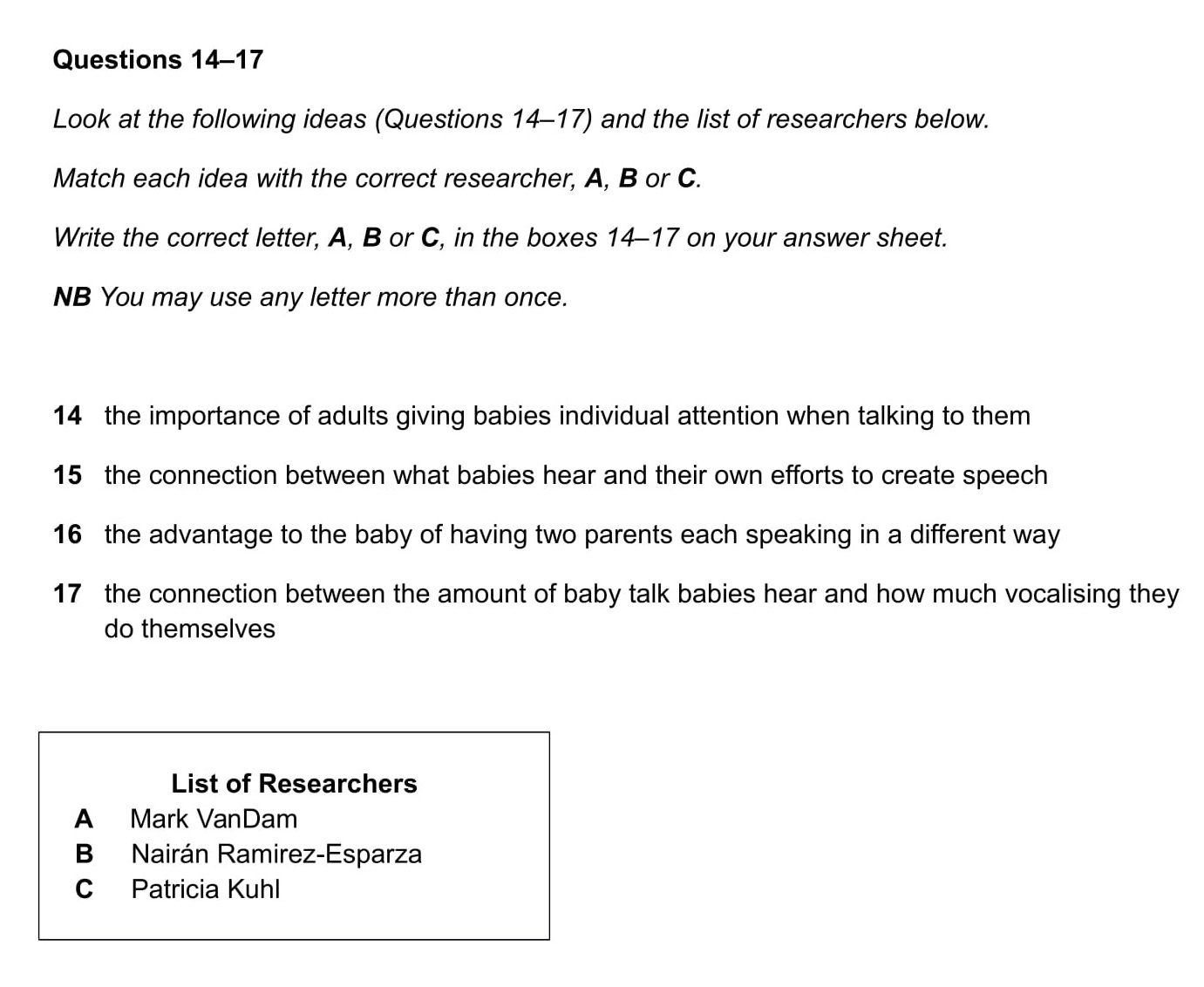
Strategy
Follow
this strategy for answering name matching questions in your IELTS Reading test.
1) Carefully read the statements and try to understand what they mean. Don’t spend too long on this but get the general meaning if you can.
2) Scan the text for the names and underline them. Do this before reading the text. You'll find them extra quickly by focusing on the capital letter at the start of the name.
Some names will appear more than once. Using a different coloured pen for each name can be helpful. Ignore any names not in the list of answers.
3) The easiest names to match to a statement will be those that appear only once in the text. Do these first. This will also quickly eliminate the matching statements from further consideration thus narrowing the options for the rest of the names.
4) The opinion, research findings or theory of the person may be stated either before or after their name appears so read the section of text around the name to locate it.
5) Carefully read the details of their opinion, research findings or theory. As you do so, think of likely synonyms that might be used in the matching statement.
6) Go to the list of statements and look for a match. When you are sure you have the correct match, fill in your answer and cross through the statement.
7) Repeat this process with the rest of the names.
Example with answers
Please note that this example
is not from a real IELTS Reading test paper. I have created it myself to demonstrate the
strategy I’ve just outlined and to give you an opportunity to practice it.
The text in your test will be longer and each name may appear several times. Other names not in the list may also be included in the text.
Follow steps 1-6 of the strategy and see if you can match all the names and statements. Then read my notes below which contain the answers.
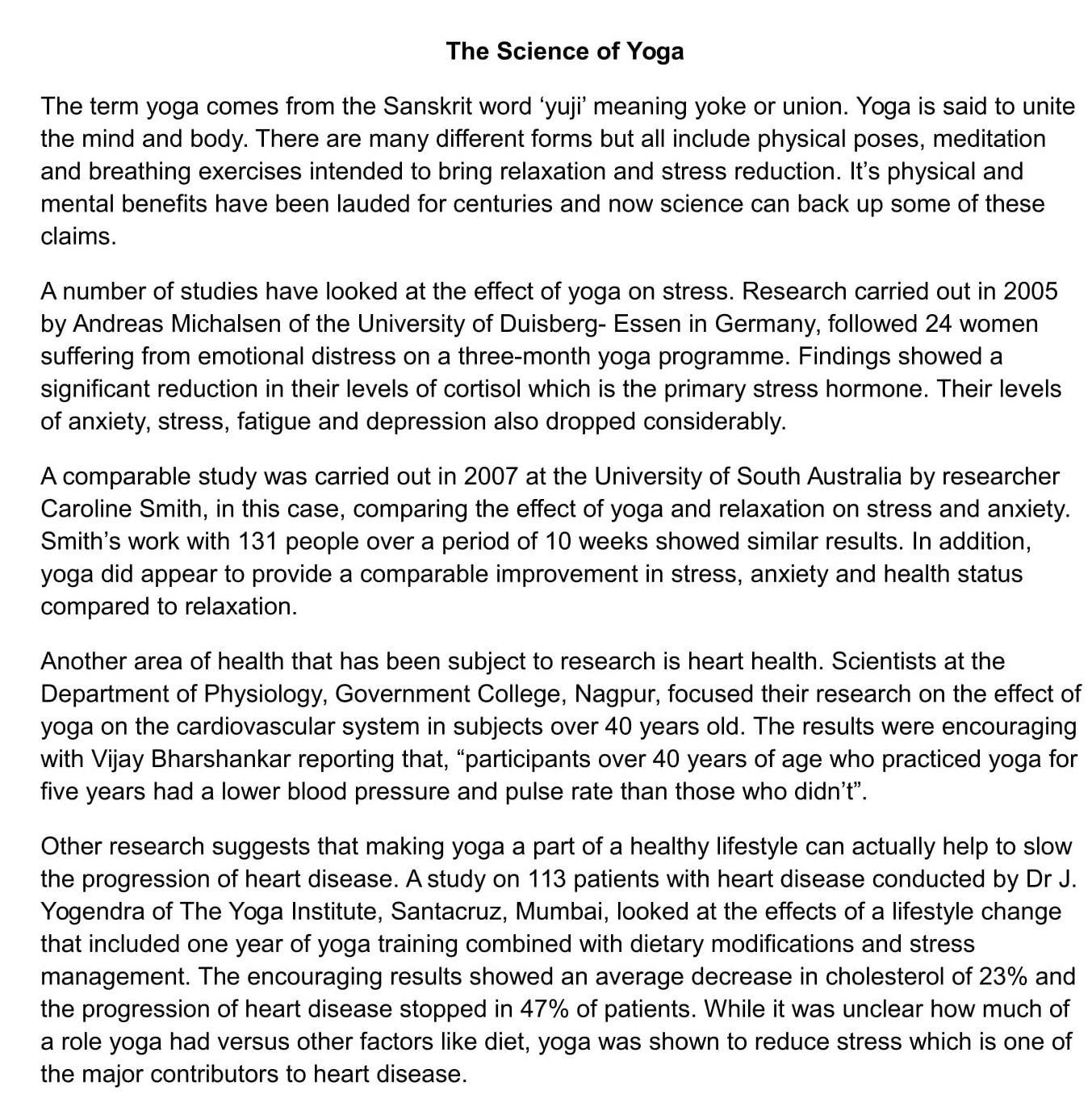
Download the PDF of this text – The Science of Yoga PDF
Questions 1–4
Look at the following ideas (Questions 1–4) and the list of researchers below.
Match each idea with the correct researcher, A, B, C or D.
Write the correct letter, A, B C or D, in the boxes 1–4 on your answer sheet.
1 the importance of yoga in decreasing the main hormone linked to stress
2 the advantage of yoga compared to relaxation in decreasing stress and anxiety
3 the significance of yoga in relation to existing cases of heart disease
4 the connection between practicing yoga and improvements in the circulatory system
List of Researchers
A Caroline Smith
B Jayadeva Yogendra
C Andreas Michalsen
D Vijay Bharshankar
Download the PDF of these matching headings questions – Questions PDF
Notes on how I answered the questions
1) Caroline Smith
In this short practice text, the names do not appear multiple times so I’m going to work down through the list from A – D. I will already have underlined them all in the text.
Here’s the paragraph the first name appears in. I’ve underlined the name and also made it bold so it stands out for you.
A comparable study was carried out in 2007 at the University of South Australia by researcher Caroline Smith in this case, comparing the effect of yoga and relaxation on stress and anxiety. Smith’s work with 131 people over a period of 10 weeks showed similar results and yoga did appear to provide a comparable improvement in stress, anxiety and health status compared to relaxation.
On reading
around the name, I would say that the main aim of her study was to ‘compare the effect of yoga and relaxation on stress and anxiety’.
‘Compare’ and ‘relaxation’ would seem to be the key words here so I now go back to the list of statements to see if I can spot them or synonyms of them. They are both in the second statement.
2 the advantage of yoga compared to relaxation in decreasing stress and anxiety
I read the statement carefully to check that the meaning is the same as in the text. I also quickly check the other statements to make sure no others have a similar meaning.
I’m sure I’m right so I fill in my answer – 2 A, cross out the statement and move on to the next name.
2) Jayadeva Yogendra
This name is in the last paragraph and appears as J. Yogendra. Reading around the name I note that this researcher studied patients with ‘heart disease’ so I start here and check the statements for these words.
Other research suggests that making yoga a part of a healthy lifestyle can actually help to help slow the progression of heart disease. A study on 131 patients with heart disease conducted by Dr J. Yogendra of The Yoga Institute, Santacruz, Mumbai, looked at the effects of a lifestyle change that included one year of yoga training combined with dietary modifications and stress management. The encouraging results showed saw an average decrease in cholesterol of 23% and the progression of heart disease stopped in 47% of patients.
I find them in statement 3. I read the statement carefully then go back to the text to see if all the information matches. It does.
3 the significance of yoga in relation to existing cases of heart disease
I also do a quick scan of the text around the names I haven’t yet matched to see if ‘heart disease’ appears again in case there is a better match. I don’t see it again so I’m happy that I have the correct answer – 3 B.
3) Andreas Michalsen
The findings of the next scientist ‘showed a significant reduction in their levels of cortisol’. I don’t really know what 'cortisol' is but I do understand the general meaning of the sentence it’s in so it doesn’t matter.
A number of studies have looked at the effect of yoga on stress. Research carried out in 2005 by Andreas Michalsen of the University of Duisberg- Essen in Germany followed 24 women suffering from emotional distress on a three-month yoga programme. Findings showed a significant reduction in their levels of cortisol which is the primary stress hormone. Their levels of anxiety, stress, fatigue and depression also dropped considerably.
I read the
remaining two statements to see if the word ‘cortisol’ appears. It doesn’t.
However, in statement 1 I do spot the word ‘decreasing’ which is a synonym of
the word ‘reduction’.
1 the importance of yoga in decreasing the main hormone linked to stress
I also notice that there’s a match for the word ‘hormone' in both the statement and the sentence in the text.
The answer is clearly – 1 C.
4) Vijay Bharshankar
This leaves me with one name and one statement. I can assume that they match but quickly double-check in case I’ve made an error with a previous match.
This time I identify the key words in the statement first. They are 'circulatory system'. This way round will be quicker as I already know which statement I'm working with.
4 the connection between practicing yoga and improvements in the circulatory system
I don’t find
a match but the term ‘cardiovascular system’ does appear.
Another area of health that has been subject to research is heart health. Scientists at the Department of Physiology, Government College, Nagpur, focused their research on the effect of yoga on the cardiovascular system in subjects above 40 years. The results were encouraging with Vijay Bharshankar reporting that, “participants over 40 years of age who practiced yoga for five years had a lower blood pressure and pulse rate than those who didn’t”.
Even if I didn’t know what either of these terms meant, I could still make a good guess from context that they are the same thing.
I’m confident that the last name and statement do match so the task is complete. The answer is 4 D.
In the real test, expect there to be more use of synonyms and paraphrasing than in my example. Here I particularly wanted to give you practice moving backwards and forward from text to statements. I hope this has been helpful.
Now practice this strategy with past test papers and you’ll soon improve your speed as well as your confidence.
Answers
1 C
2 A
3 B
4 D
Want to watch the video of this page? Click here.
Like this page?
Lessons On All Question Types
For more sample questions with step-by-step instructions, see the IELTS Reading menu page.
More Reading Test Pages
IELTS Reading Test – Understand the format, question types & marking system & know what skills are assessed. Also learn success strategies, key reading skills & discover top tips.
IELTS Reading Skills – Master the skills of skimming, scanning & detailed reading. Understand the importance of topic sentences & how to use context for meaning & unfamiliar words.
Top 7 IELTS Reading Tips – Each tip will take you a step closer to the high score you want. They are the key to top marks in your test.
9 More Tips For IELTS Reading – Learn valuable practice techniques & discover a secret that may gain you extra marks.
IELTS Reading Practice – Discover the top 5 things you must do to prepare for your reading test.
How to Complete the IELTS Reading Test in 60 Minutes – Top 6 Recommendations.
IELTS Academic Reading – Why you should take IELTS Academic Reading, test format, text types &
sample tests.
IELTS General Reading – Why you should take IELTS General Reading, test format, text types & sample tests.
Reading Practice Samples – Short activities to improve your reading skills & help you learn topic vocabulary.



